Exploring Liu Kang’s Paris Practice (1929–1932): Insight into Painting Materials and Technique
Abstract
:1. Introduction
2. Materials and Methods
2.1. Materials
2.1.1. Investigated Paintings
2.1.2. Samples
2.2. Methods
2.2.1. Technical Photography
2.2.2. RTI
2.2.3. XRR
2.2.4. XRF
2.2.5. MA-XRF
2.2.6. FE-SEM-EDS
2.2.7. ATR-FTIR
2.2.8. OM and PLM
2.2.9. Preparation of Samples
2.3. Archival Sources
3. Results and Discussion
3.1. Pigments
3.1.1. Blue
3.1.2. Green
3.1.3. Yellow
3.1.4. Brown
3.1.5. Red
3.1.6. White
3.1.7. Black
3.2. Binding Media and Other Identified Compounds
3.3. Painting Process
3.4. Reusing Earlier Paintings
4. Conclusions
Author Contributions
Funding
Institutional Review Board Statement
Informed Consent Statement
Data Availability Statement
Acknowledgments
Conflicts of Interest
Appendix A
| Title and Inventory Number | Date | Colour | Sample | SEM-EDS * and XRF ** Detected Elements | PLM, SEM-EDS, XRF Assignment | FTIR Identification |
|---|---|---|---|---|---|---|
| Autumn colours, GI-0255 (PC) | 1930 | Blue | 19 | C, O, Pb, Cr, Ca, Si, Al, Na, Ba, S, As, (Sr, Fe, Cu, Zn) | Lead white, lithopone and/or barium white and zinc white, chalk, viridian, ultramarine, emerald green or Sheele’s green, Prussian blue | |
| Green | 5 | C, O, Pb, Ba, Sr, S, As, Cr, Cu, (Si, Ca, Al, Fe, Na) | Lead white, barium white, chalk, viridian, emerald green or Sheele’s green, Prussian blue | |||
| Green | 18 | C, O, As, Cu, Ba, Pb, S, Ca, (Ti, Na, Cr, Cl, Si, Fe, Mn) | Emerald green, barium white, lead white, chalk, viridian, umber, possible Cr-containing yellow(s) and titanium white | Emerald green, lithopone and/or barium white, lead white, possible chrome yellow, oil | ||
| Yellow | 3 | Pb, C, O, Ca, (Cl, Cr, Si, Al, Fe, Ba) | Lead white, chrome yellow, chalk, barium white, yellow iron oxide | |||
| Brown | 4 | Pb, C, O, Ca, Fe, Al, Si, (Cr, Ba, Sr, Ti, Na) | Lead white, chalk, yellow iron oxide, barium white, possible Cr-containing yellow(s), and titanium white | |||
| Red | 7 | O, C, Fe, Pb, Ca, Ti, Si, Al, Mg, (P, Na, Sr, Cl, Zn, K, Cr, S) | Red iron oxide, lead white, chalk, titanium white, bone black, possible Cr-containing yellow(s) | |||
| Black | 9 | C, O, Ca, Pb, P, (Si, Al, Na, Fe, Ba, Mg, Cr, Cl, Zn, As) | Bone black, lead white, lithopone and/or barium white and zinc white | |||
| White | 2 | Pb, C, O, Ca, (Al, Cl, Si, Zn) | Lead white, chalk, zinc white | |||
| Countryside in France, 2003-03365 | 1930 | Blue | 5 | C, Pb, O, Si, Al, Ca, Ba, Na, S, Zn, (Ni, K, Cr, Ti, Sr, Mg) | Lead white, carbon black, ultramarine, lithopone and/or barium white and zinc white, possible titanium white | |
| Green | 11 | O, Pb, C, Ba, Cr, Fe, S, Ca, Si, Al, Ti, (Na, K, Zn, Cl) | Lead white, chalk, lithopone and/or barium white and zinc white, viridian, Prussian blue, possible Cr-containing yellow(s), titanium white | Lead white, chalk, lithopone and/or barium white and zinc white, Prussian blue, possible chrome yellow, oil, acrylic resin assigned to the conservation varnish | ||
| Green | 4 | Pb, C, O, Cr, Ca, Ba, Si, Zn, Al, (S, Fe, Ti, Na) | Lead white, chrome yellow, possible other Cr-containing yellow(s), chalk, viridian, lithopone and/or barium white and zinc white, Prussian blue | |||
| Yellow | 9 | Pb, C, O, Cr, (S, Cl, Na, Zn, Al) | Chrome yellow, zinc white | |||
| Brown | 41 | Pb, Fe, K, Si, Ca | Lead white, iron oxide, chalk | |||
| Brown | 49 | Fe, Ca | Iron oxide, chalk | |||
| Red | 7 | C, Pb, Ba, O, S, Cr, Al, Si, (Zn, Ni, Sr, Ca, P) | Lead white, chrome yellow, lithopone and/or barium white and zinc white, organic red, bone black | Lead white, chrome yellow, lithopone and/or barium white and zinc white, organic red, oil, zinc soap | ||
| Black | 16 | O, C, Pb, Si, Al, Na, Ba, S, Zn, Ca, (K, Cr, Ti, Sr) | Lead white, ultramarine, carbon black, lithopone and/or barium white and zinc white | |||
| White | 29 | C, Pb, O, Ba, Ti, Zn, S, Na, (Fe, Si, Al) | Lead white, barium white, zinc white, titanium white | Lead white, barium white, zinc white, oil, proteins | ||
| Landscape in Switzerland, P-1229 | 1930 | Blue | 5 | Zn, C, O, Na, Al, Ca, Si, (S, Pb, Sr, Mg) | Zinc white, ultramarine, lead white | |
| Green | 20 | Pb, C, O, Zn, Cr, Fe, Na, (Ba, Si, Al, Ca, Cl) | Chrome yellow, yellow iron oxide, Prussian blue, lead white, lithopone and/or barium white and zinc white | Chrome yellow, possible iron oxide, Prussian blue, lead white, lithopone and/or barium white and zinc white, oil, zinc soap, acrylic resin assigned to the conservation varnish | ||
| Green | 21 | C, O, Cd, Cr, S, Ba, Zn, Cl, (Na, Pb, Al, Si, Sn, Ti, Ca, Sr) | Cadmium yellow, lithopone and/or barium white and zinc white, viridian, chalk, lead white, chrome yellow, possible titanium white | |||
| Green | 24 | C, O, Pb, Ba, Zn, Cr, Al, Cl, Na, S, Fe, (Cu, Mg, Si, Ti, Ca, As, Sr, P) | Chrome yellow, viridian, Prussian blue, lithopone and/or barium white and zinc white, emerald green or Sheele’s green, possible titanium white | |||
| Yellow | 23 | Pb, O, Zn, C, K, Na, Ba, Co, Cd, (Mg, Ca, Fe, Si, S, Al, Cr, Cl) | Chrome yellow, possible other Cr-containing yellow(s), lithopone and/or barium white and zinc white, cobalt yellow, cadmium yellow, yellow iron oxide | |||
| Yellow | 36 | Zn, C, O, Pb, Na, Ca, Fe, K, Ba, Co, (Si, As, S, Mg, Al, Cr, Cl) | Lithopone and/or barium white and zinc white, lead white, chrome yellow, possible other Cr-containing yellow(s), yellow iron oxide, cobalt yellow | |||
| Brown | 25, layer 2 | O, Zn, C, Ba, Na, Pb, Fe, Ca, S, Al, Si, K, (Ti, Co, Mg, As, Sr, Cu) | Lithopone and/or barium white and zinc white, lead white, yellow iron oxide, cobalt yellow, possible emerald green or Sheele’s green and titanium white | |||
| Red | 25, layer 1 | C, O, Pb, Ca, Sn, Si, Fe, (Al, Ba, Zn, Na, Cl, Cr, Mg) | Lead white, organic red, red iron oxide, starch | |||
| Red | 35, layer 2 | O, Fe, C, Si, Al, Ca, (K, Sn, Mg, Ti, S, Pb, Zn) | Red iron oxide, organic red, chalk | Red iron oxide, organic red, chalk, oil | ||
| Red | 35, layer 1 | C, O, Pb, Sn, (Cr, Fe, Ca, Si, Al, Cl) | Lead white, organic red, iron oxide, possible Cr-containing yellow(s) | Lead white, organic red, iron oxide, starch, oil | ||
| Black | 18 | C, O, Zn, Al, Ca, Ba, S, Na, (Si, Fe, Pb, P, Sr, Mg, Cu, Cl) | Lithopone and/or barium white and zinc white, ultramarine, bone black, Prussian blue | |||
| White | 22 | Zn, C, O, Na, (S, Ba, Mg, Ca, Al) | Lithopone and/or barium white and zinc white, chalk | |||
| Village scene, 2003-03320 | 1931 | Blue | 20 | Pb, C, O, Ca, (Na, Si, Al, Cr, Cl, Mg, Sr, Zn) | Lead white, ultramarine, viridian, chalk, possible zinc white | |
| Green | 2 | C, Pb, O, Ba, Ca, Cr, S, Fe, (Zn, Al, Na, Si, Ti, Mg) | Lead white, lithopone and/or barium white and zinc white, chalk, viridian, Prussian blue | |||
| Green | 3 | O, Cr, C, Pb, Ca, (Zn, Na, Si, Mg, Al) | Viridian, lead white, chrome yellow, possible other Cr-containing yellow(s), chalk | |||
| Yellow | 8 | Pb, C, O, Cr, (Ca, S, Na, Si, Cl, Al) | Chrome yellow, chalk | |||
| Brown | 5 | Pb, C, O, Ca, Fe, Si, Al, (Zn, Sr, Mg, Cl, Ba, Cr, P) | Lead white, lithopone and/or barium white and zinc white, yellow iron oxide, bone black, possible Cr-containing yellow(s) | |||
| Brown | 10 | O, Fe, C, Ba, S, Ca, Si, (Pb, Al, Ti, Sr, Cl) | Yellow iron oxide, barium white, chalk, lead white | |||
| Red | 9 | C, O, Pb, Sn, Ca, Cr, Si, Fe, (Al, Zn, Ba, P) | Chrome yellow, possible lead white, organic red, starch, chalk, lithopone and/or barium white and zinc white, red iron oxide, bone black | Chrome yellow, possible lead white, organic red, iron oxide, starch, chalk, oil | ||
| Black | 13 | O, C, Ca, Si, Pb, Na, Al, S, P, Zn, (Ba, K, Fe, Sr, Cr, Cl) | Ultramarine, lead white, lithopone and/or barium white and zinc white, Prussian blue, bone black | |||
| Black | 14 | O, Pb, C, Si, Al, Na, S, Ca, (K, As, Zn, Ba, Fe, Sr, Cl) | Lead white, ultramarine, lithopone and/or barium white and zinc white, red iron oxide, carbon black | |||
| White | 17 | Pb, C, O, Ca, (Cl, Al, Mg) | Lead white, chalk | |||
| French lady, 1993-00996 | 1931 | Blue | 20 | C, O, Pb, Al, Ca, Ba, Si, Co, Na, (S, Cr, Mg, Ti, Sr, K, P, Fe, Zn, Cl) | Lead white, chalk, lithopone and/or barium white and zinc white, cobalt blue, viridian, ultramarine, bone black | |
| Green | 15 | C, O, Pb, Cr, Ba, Ca, (As, Si, Al, Na, Cu, Ti, Fe, Co, Cl, S) | Lead white, viridian, chalk, barium white, cobalt blue, Prussian blue, possible emerald green or Sheele’s green and titanium white | |||
| Green | 16 | Pb, C, O, Ba, Ca, As, Cr, S, Cu, (Fe, Ti, Na, Al, Si, Cl) | Lead white, barium white, chalk, emerald green or Sheele’s green, Prussian blue, possible Cr-containing yellow(s) and titanium white | Lead white, lithopone and/or barium white, chalk, possible emerald green or Sheele’s green, Prussian blue, chrome yellow, oil, lead soap | ||
| Brown | 17 | Pb, O, C, Ca, Si, Fe, Al, (Zn, Ba, Cr, Cl, Mg, K, Na, Ti) | Lead white, yellow iron oxide, Cr-containing yellow(s), lithopone and/or barium white and zinc white | |||
| Red | 9 | Pb, C, O, Ca, Ba, Fe, Si, (Al, Cl, Cr, Ti, Mg) | Lead white, chalk, Cr-containing yellow(s), barium white, iron oxide | |||
| Black | 19 | O, C, Fe, Ba, Pb, Al, S, Co, Na, K, Si, As, (Ca, P, Ti, Zn, Mg, Cr, Sr, Cl) | Prussian blue, lithopone and/or barium white and zinc white, lead white, cobalt blue, bone black, viridian, possible titanium white | |||
| Black | 6 | O, C, Pb, Si, Al, S, Na, Ca, As, K, Fe, (Sr, Ba, Cl, Mg, Ti, Cr) | Lead white, ultramarine, carbon black, Prussian blue, barium white, viridian, possible titanium white | |||
| Boat near the cliff, 2003-03249 | 1931 | Blue | 3 | C, Zn, O, Ba, Na, S, Cr, (Al, Si, Sr) | Lithopone and/or barium white and zinc white ultramarine, viridian | |
| Blue | 21 | C, O, Na, Zn, Al, Si, S, Ba, (K, Sr, Cr, Ca, Cl) | Ultramarine, viridian, lithopone and/or barium white and zinc white | |||
| Blue | 26 | C, O, Ba, Zn, S, Cr, Na, Pb, (Ti, Ca, Al, Si, Co, Mg) | Lithopone and/or barium white and zinc white, lead white, viridian, ultramarine, cobalt blue | |||
| Green | 11 | O, C, Ba, Zn, Pb, S, Fe, Cr, Ca, Na, Si, (Al, Ti, Mg, P, Cl, K) | Lithopone and/or barium white and zinc white, chalk, chrome yellow, yellow iron oxide, Prussian blue, viridian, bone black, possible titanium white | |||
| Green | 12 | O, C, Ba, Ca, Pb, S, Cr, Fe, (Ti, Sr, Si, Al, Na, Zn) | Lithopone and/or barium white and zinc white, viridian, Prussian blue, chrome yellow | |||
| Yellow | 25 | O, C, Ba, Ca, Pb, S, Zn, Cr, (Sr, Na, Ti, Mg, Si, Al, Cd, Fe) | Lithopone and/or barium white and zinc white, chrome yellow, cadmium yellow, iron oxide, possible titanium white | |||
| Brown | 14 | C, O, Zn, Fe, Na, Al, Ba, (Ca, P, S, Si, Mn, Mg, Cr, Pb, Sr) | Lithopone and/or barium white and zinc white, umber, bone black, chrome yellow, possible other Cr-containing yellow(s) | |||
| Red | 29 | C, O, Pb, Ba, Br, Al, S, (Si, Ti, Cl, Ca) | Br-containing organic red on Pb- or Al-based substrate, barium white, possible titanium white | Lithopone and/or barium white, organic red, oil, acrylic resin assigned to the conservation varnish | ||
| Black | 17 | C, O, Zn, Pb, Na, Mg, (Si, Al, Fe, S, Ba, Ca, K) | Lithopone and/or barium white and zinc white, lead white, carbon black, Prussian blue | |||
| White | 22 | Zn, C, O, Na, (Si, Mg, Pb, Al) | Zinc white, lead white | |||
| Breakfast, GI-0257 (PC) | 1932 | Green | 4 | O, Cr, C, Pb, Ba, S, Ca, (Na, Al, Si, Mg, Ti, Sr) | Viridian, lead white, barium white, chalk, possible titanium white | |
| Yellow | 3 | O, C, Fe, Si, Pb, Al, Ca, (K, As, Cr, Sr, P, Ba, Cl, Ti, Zn) | Yellow iron oxide, chrome yellow, lead white, lithopone and/or barium white and zinc white, bone black, possible titanium white | |||
| Brown | 10 | O, C, Fe, Si, Pb, Al, Sn, Ca, Sr, Ba, K, (Ti, Cr, Mg, Cl, Zn, P) | Red iron oxide, organic red, lead white, chalk, Prussian blue, starch, Cr-containing yellow(s), lithopone and/or barium white and zinc white, bone black, possible titanium white | Red iron oxide, organic red, lead white, chalk, Prussian blue, starch, oil | ||
| Black | 14 | O, Ca, Pb, C, Cr, P, Ba, Si, (Fe, Al, Na, Ti, Mg, K, Cl, Sr) | Lead white, bone black, viridian, barium white, Prussian blue, possible titanium white | |||
| White | 7 | Pb, C, O, Ca, (Cl, Si, Na, Al, Mg) | Lead white, chalk |
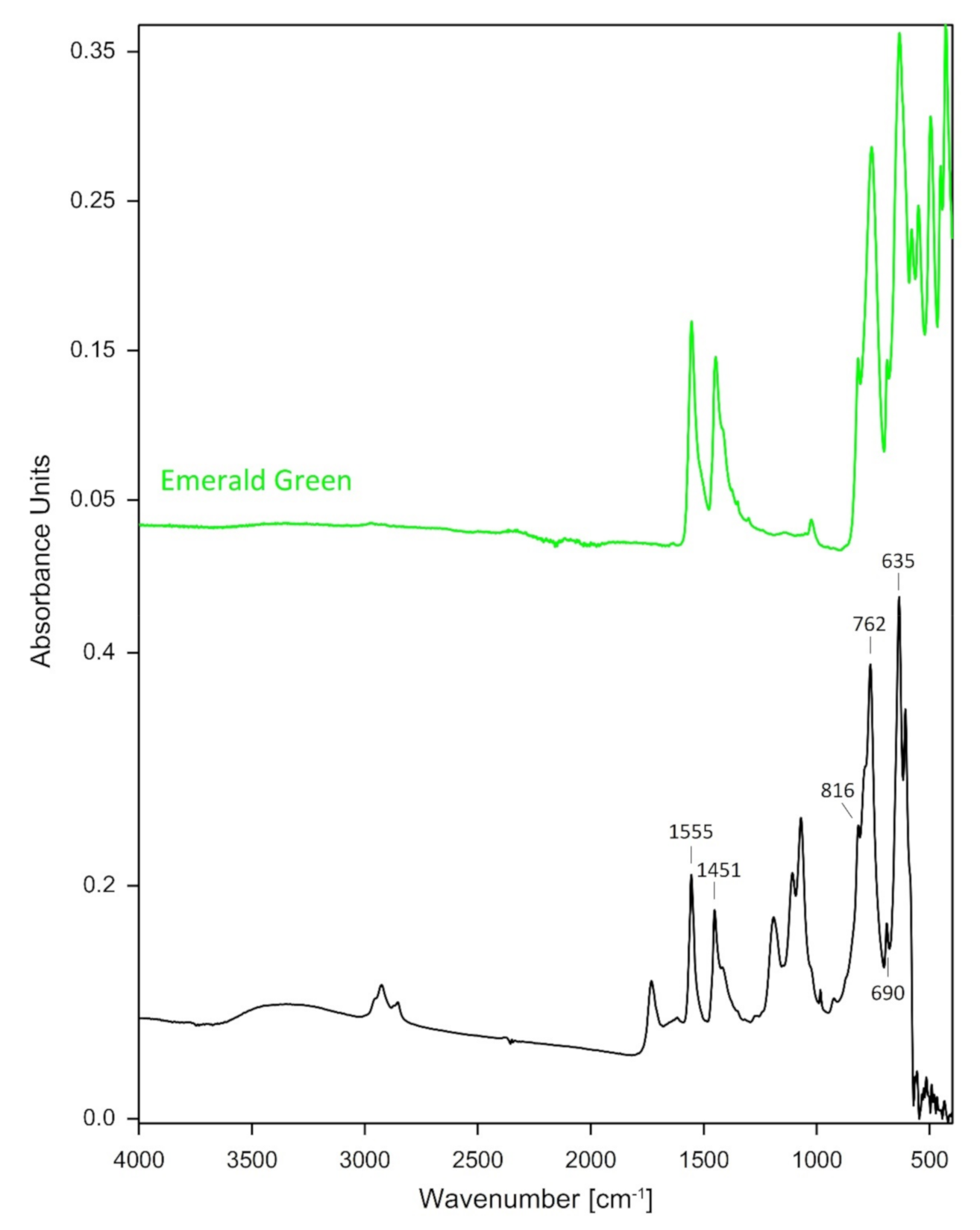

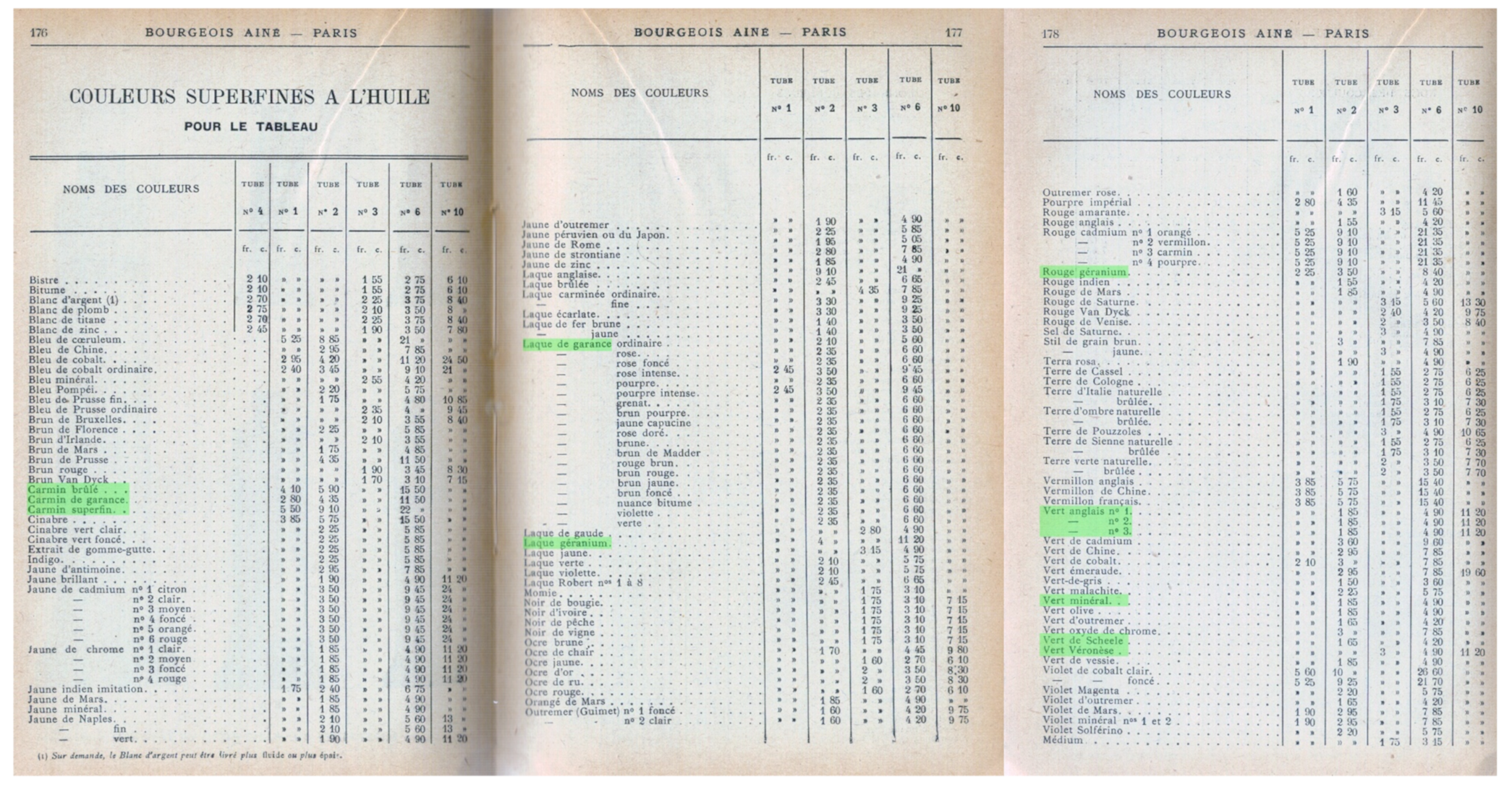
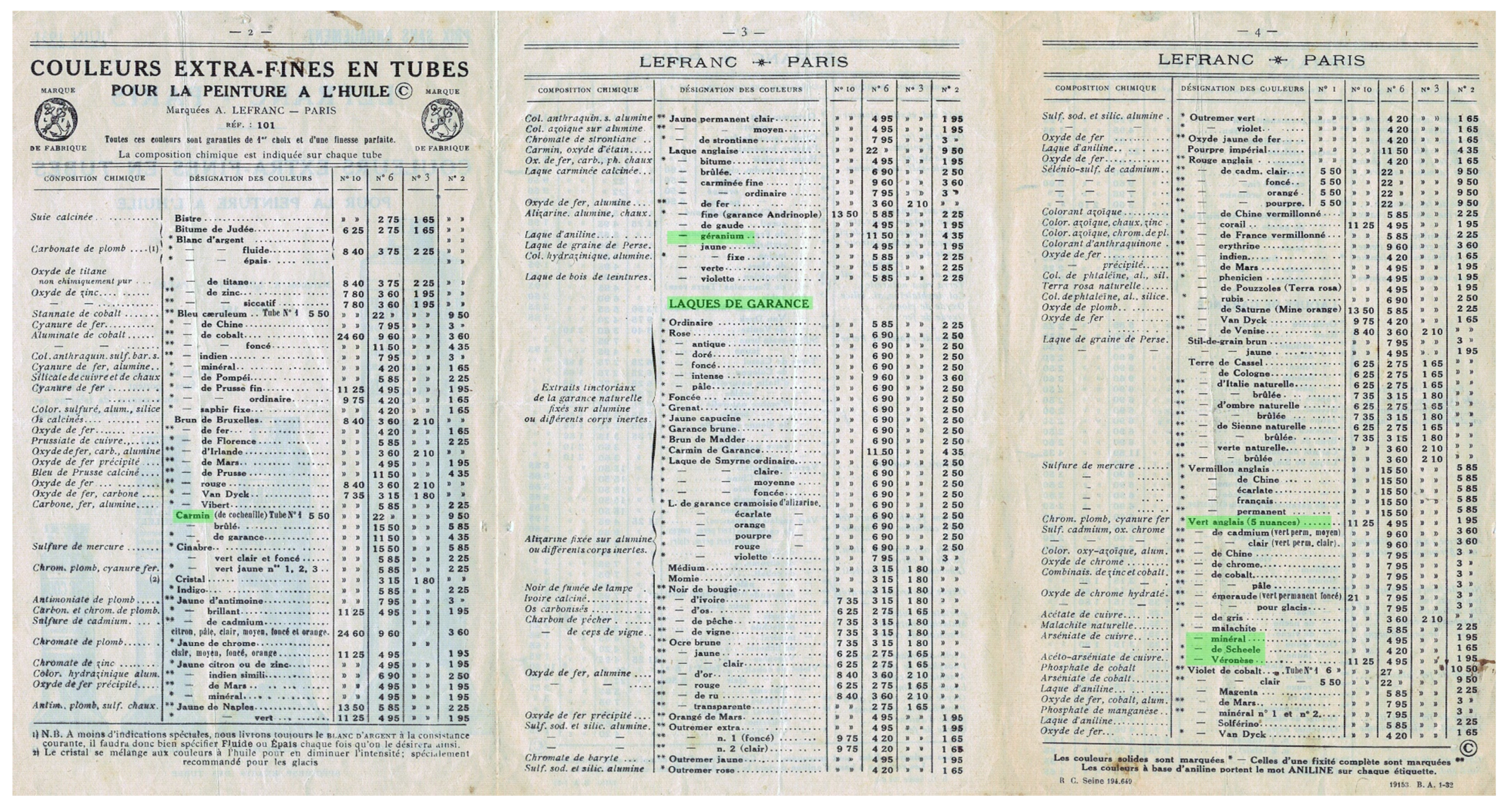
References
- Croizier, R. Post-Impressionists in Pre-War Shanghai: The Juelanshe (Storm Society) and the Fate of Modernism in Republican Shanghai. In Modernity in Asian Art; Clark, J., Ed.; Wild Peony: Broadway, NSW, Australia, 1993; p. 135. [Google Scholar]
- Zheng, J. The Modernization of Chinese Art: The Shanghai Art College, 1913–1937; Leuven University Press: Leuven, Belgium, 2016; pp. 92, 96. [Google Scholar]
- Kwok, K.C. Journeys: Liu Kang and His Art = Yi Cheng: Liu Kang Qi Ren Qi Yi; National Arts Council: Singapore, 2000; p. 49. [Google Scholar]
- Liu, K. Liu Haisu and Contemporary Chinese Art. In Liu Kang: Essays on Art & Culture; Siew, S., Ed.; National Art Gallery: Singapore, 2011; p. 153. [Google Scholar]
- Liu, K. Liu Kang Ba Shi Ba Sui = Liu Kang at 88F; Singapore Soka Association: Singapore, 1998; p. 22. [Google Scholar]
- Ong, Z.H.; Wong, S.; Ong, P.; Tng, P. Life of Love, Life of Art; Yeo, W.W., Ed.; National Art, Gallery: Singapore, 2011; p. 34. [Google Scholar]
- Lizun, D. A preliminary study of Liu Kang’s palette and the discovery and interpretation of hidden paint layers. Herit. Sci. 2020, 8, 21. [Google Scholar] [CrossRef] [Green Version]
- Lizun, D.; Szroeder, P.; Kurkiewicz, T.; Szczupak, B. Examination of painting technique and materials of Liu Kang’s Seafood and hidden self-portrait. Int. J. Conserv. Sci. 2021, 12, 3–26. [Google Scholar]
- Lizun, D.; Kurkiewicz, T.; Szczupak, B. Technical examination of Liu Kang’s Paris and Shanghai painting supports (1929–1937). Herit. Sci. 2021, 9, 37. [Google Scholar] [CrossRef]
- Liu, K.; Fu, L.; Fu, T.O. Liu Kang: Essays on Art & Culture; Siew, S., Ed.; National Art Gallery: Singapore, 2011; p. 126. [Google Scholar]
- Cosentino, A. Identification of pigments by multispectral imaging; a flowchart method. Herit. Sci. 2014, 2, 12. [Google Scholar] [CrossRef] [Green Version]
- Cosentino, A. Practical notes on ultraviolet technical photography for art examination. Conserv. Património 2015, 53–62. [Google Scholar] [CrossRef] [Green Version]
- Cosentino, A. Infrared technical photography for art examination. e-Preserv. Sci. 2016, 13, 1–6. [Google Scholar]
- Warda, J.; Frey, F.; Heller, D.; Kushel, D.; Vitale, T.; Weaver, G. The AIC Guide to Digital Photography and Conservation Documentation; American Institute for Conservation of Historic and Artistic Works: Washington, DC, USA, 2011. [Google Scholar]
- Schroer, C.; Bogart, J.; Mudge, B.; Lum, M. Guide to Highlight Image Capture. Available online: http://culturalheritageimaging.org/What_We_Offer/Downloads/RTI_Hlt_Capture_Guide_v2_0.pdf (accessed on 27 March 2021).
- Schroer, C.; Bogart, J.; Mudge, B.; Lum, M. Guide to Highlight Image Processing. Available online: http://culturalheritageimaging.org/What_We_Offer/Downloads/rtibuilder/RTI_hlt_Processing_Guide_v14_beta.pdf (accessed on 27 March 2021).
- Schroer, C.; Bogart, J.; Mudge, B.; Lum, M. Guide to RTIViewer. Available online: http://culturalheritageimaging.org/What_We_Offer/Downloads/rtiviewer/RTIViewer_Guide_v1_1.pdf (accessed on 27 March 2021).
- Alfeld, M.; Pedroso, J.V.; van Eikema Hommes, M.; van der Snickt, G.; Tauber, G.; Blaas, J.; Haschke, M.; Erler, K.; Dik, J.; Janssens, K. A mobile instrument for in situ scanning macro-XRF investigation of historical paintings. J. Anal. At. Spectrom. 2013, 28, 760–767. [Google Scholar] [CrossRef]
- Mactaggart, P.; Mactaggart, A. A Pigment Microscopist’s Notebook; Chard: Mactaggart, AB, Canada, 1998. [Google Scholar]
- Le Salon 1930. Société Des Artistes Français; Imprimerie Georges Lang: Paris, France, 1930. [Google Scholar]
- Le Salon 1932. Société Des Artistes Français; Imprimerie Georges Lang: Paris, France, 1932. [Google Scholar]
- Catalogue De La 41e Exposition Au Grand Palais Des Champs-Elysées Du 17 Janvier Au 2 Mars 1930; Société Des Artistes Indépendants: Paris, France, 1930.
- Berrie, B.H. Prussian Blue. In Artists’ Pigments: A Handbook of Their History and Characteristics; West FitzHugh, E., Ed.; National Gallery of Art: Washington, DC, USA, 1997; Volume 3, p. 195. [Google Scholar]
- Kirby, J.; Saunders, D. Fading and colour change of Prussian blue: Methods of manufacture and the influence of extenders. Natl. Gallery Tech. Bull. 2004, 25, 73–99. [Google Scholar]
- Feller, R.L. Barium Sulfate–Natural and Synthetic. In Artists’ Pigments: A Handbook of Their History and Characteristics; Feller, R.L., Ed.; National Gallery of Art: Washington, DC, USA, 1986; Volume 1, p. 47. [Google Scholar]
- Newman, R. Chromium Oxide and Hydrated Chromium Oxide. In Artists’ Pigments: A Handbook of Their History and Characteristics; West FitzHugh, E., Ed.; National Gallery of Art: Washington, DC, USA, 1997; Volume 3, p. 281. [Google Scholar]
- Buti, D.; Rosi, F.; Brunetti, B.G.; Miliani, C. In-situ identification of copper-based green pigments on paintings and manuscripts by reflection FTIR. Anal. Bioanal. Chem. 2013, 405, 2699–2711. [Google Scholar] [CrossRef] [PubMed]
- Bomford, D.; Kirby, J.; Leighton, J.; Roy, A. Art in the Making: Impressionism; National Gallery: London, UK, 1990; pp. 48, 61. [Google Scholar]
- Fiedler, I.; Bayeard, M.A. Emerald green and Sheele’s green. In Artists’ Pigments: A Handbook of Their History and Characteristics; West FitzHugh, E., Ed.; National Gallery of Art: Washington, DC, USA, 1997; Volume 3, p. 238. [Google Scholar]
- Kühn, H.; Curran, M. Chrome Yellow and Other Chromate Pigments. In Artists’ Pigments: A Handbook of Their History and Characteristics; Feller, R.L., Ed.; National Gallery of Art: Washington, DC, USA, 1986; Volume 1, pp. 190, 194, 196, 207. [Google Scholar]
- Fiedler, I.; Bayard, M.A. Cadmium Yellows, Oranges and Reds. In Artists’ Pigments: A Handbook of Their History and Characteristics; Feller, R.L., Ed.; National Gallery of Art: Washington, DC, USA, 1986; Volume 1, pp. 65, 74, 80. [Google Scholar]
- Eastaugh, N.; Walsh, V.; Chaplin, T.; Siddall, R. Pigment Compendium: A Dictionary and Optical Microscopy of Historical Pigments; Butterworth-Heinemann: London, UK, 2008; pp. 103, 157, 173. [Google Scholar]
- Helwig, L. Iron Oxide Pigments: Natural and Synthetic. In Artists’ Pigments: A Handbook of Their History and Characteristics; Berrie, B.H., Ed.; National Gallery of Art: Washington, DC, USA, 2007; Volume 4, p. 73. [Google Scholar]
- Gettens, R.J.; Stout, G.L. Painting Materials: A Short Encyclopaedia; Dover Publications: New York, NY, USA, 2015; p. 110. [Google Scholar]
- Corman, M. Cobalt Yellow (Aureolin). In Artists’ Pigments: A Handbook of Their History and Characteristics; Feller, R.L., Ed.; National Gallery of Art: Washington, DC, USA, 1986; Volume 1, p. 37. [Google Scholar]
- Kirby, J.; van Bommel, M.; Verhecken, A.; Spring, M.; Vanden Berghe, I.; Stege, H.; Richter, M. Natural Colorants for Dyeing and Lake Pigments: Practical Recipes and Their Historical Sources; Archetype Publications: London, UK, 2014; pp. 78, 101. [Google Scholar]
- Schweppe, H.; Roosen-Runge, H. Carmine–Cochineal Carmine and Kermes Carmine. In Artists’ Pigments: A Handbook of Their History and Characteristics; Feller, R.L., Ed.; National Gallery of Art: Washington, DC, USA, 1986; Volume 1, pp. 263, 272. [Google Scholar]
- Schweppe, H.; Winter, J. Madder and Alizarin. In Artists’ Pigments: A Handbook of Their History and Characteristics; West FitzHugh, E., Ed.; National Gallery of Art: Washington, DC, USA, 1997; Volume 3, pp. 112, 124, 131. [Google Scholar]
- van Bommel, M.; Geldof, M.; Hendriks, E. An Investigation of Organic Red Pigments Used in Paintings by Vincent Van Gogh (November 1885 to February 1888). In ArtMatters-Netherlands Technical Studies in art; Hermens, E., Ed.; Waanders Publishers: Zwolle, The Netherlands, 2005; Volume 3, pp. 128, 129. [Google Scholar]
- Centeno, S.A.; Hale, C.; Carò, F.; Cesaratto, A.; Shibayama, N.; Delaney, J.; Dooley, K.; van der Snickt, G.; Janssens, K.; Stein, S.A. Van Gogh’s Irises and roses: The contribution of chemical analyses and imaging to the assessment of color changes in the red lake pigments. Herit. Sci. 2017, 5, 18. [Google Scholar] [CrossRef] [Green Version]
- Geldof, M.; de Keijzer, M.; van Bommel, M.; Pilz, K.; Salvant, J.; van Keulen, H.; Megens, L. Van Gogh’s Geranium Lake. In Van Gogh’s Studio Practice; Jansen, L., Geldof, M., Haswell, R., Hendriks, E., van Heugten, S., Eds.; Yale University Press: New Haven, CT, USA, 2013; pp. 268–289. [Google Scholar]
- Ghelardi, E.; Degano, I.; Colombini, M.P.; Mazurek, J.; Schilling, M.; Learner, T. Py-GC/MS applied to the analysis of synthetic organic pigments: Characterization and identification in paint samples. Anal. Bioanal. Chem. 2015, 407, 1415–1431. [Google Scholar] [CrossRef] [PubMed]
- Painting Examination and Treatment Report. Boat Near the Cliff. Conservation ID:101356; Heritage Conservation Centre: Singapore, 2006.
- Fieberg, J.E.; Knutås, P.; Hostettler, K.; Smith, G.D. “Paintings fade like flowers”: Pigment analysis and digital reconstruction of a faded pink lake pigment in Vincent van Gogh’s Undergrowth with two figures. Appl. Spectrosc. 2017, 71, 794–808. [Google Scholar] [CrossRef] [PubMed]
- Kirby, J. The Reconstruction of Late 19th-Century French Red Lake Pigments. In Art of the Past: Sources and Reconstruction: Proceedings of the First Symposium of the Art Technological Source Research Study Group; Clarke, M., Townsend, J., Stijnman, A., Eds.; Archetype Publications, ICN Amsterdam: London, UK, 2005; p. 75. [Google Scholar]
- de Keijzer, M.; van Bommel, M. Bright New Colours: The History and Analysis of Fluorescein, Eosin, Erythrosine, Rhodamine and Some of Their Derivatives. In The Diversity of Dyes in History and Archaeology; Kirby, J., Ed.; Archetype Publications: London, UK, 2017; pp. 326–338. [Google Scholar]
- Pozzi, F.; Basso, E.; Centeno, S.A.; Smieska, L.M.; Shibayama, N.; Berns, R.; Fontanella, M.; Stringari, L. Altered identity: Fleeting colors and obscured surfaces in Van Gogh’s Landscapes in Paris, Arles, and Saint-Rémy. Herit. Sci. 2021, 9, 15. [Google Scholar] [CrossRef]
- Degano, I.; Tognotti, P.; Kunzelman, D.; Modugno, F. HPLC-DAD and HPLC-ESI-Q-ToF characterisation of early 20th century lake and organic pigments from Lefranc archives. Herit. Sci. 2017, 5, 7. [Google Scholar] [CrossRef] [Green Version]
- Kirby, J.; Spring, M.; Higgitt, C. The technology of red lake pigment manufacture: Study of the dyestuff substrate. Natl. Gallery Tech. Bull. 2005, 26, 71–87. [Google Scholar]
- Kühn, H. Zinc white. In Artists’ Pigments: A Handbook of Their History and Characteristics; Feller, R.L., Ed.; National Gallery of Art: Washington, DC, USA, 1986; Volume 1, p. 178. [Google Scholar]
- Duffy, M.; Martins, A.; Boon, J.J. Metal Soaps and Visual Changes in a Painting by René Magritte–The Menaced Assassin, 1927. In Issues in Contemporary Oil Paint; van den Berg, K.J., Burnstock, A., de Keijzer, M., Krueger, J., Learner, T., Tagle, d.A., Heydenreich, G., Eds.; Springer International Publishing: Cham, Switzerland, 2014; pp. 197–203. [Google Scholar]
- Hermans, J.J.; Keune, K.; Van Loon, A.; Iedema, P.D. Toward a Complete Molecular Model for the Formation of Metal Soaps in Oil Paints. In Metal Soaps in Art: Conservation and Research; Casadio, F., Keune, K., Noble, P., Van Loon, A., Hendriks, E., Centeno, S.A., Osmond, G., Eds.; Springer International Publishing: Cham, Switzerland, 2019; pp. 47–67. [Google Scholar]
- Painting Examination and Treatment Report. Countryside in France. Conservation ID: 113162; Heritage Conservation Centre: Singapore, 2006.
- Painting Examination and Treatment Report. Landscape in Switzerland. Conservation ID: 102968; Heritage Conservation Centre: Singapore, 1993.
- Callen, A. The Art of Impressionism: Painting Technique & the Making of Modernity; Yale University Press: New Haven, CT, USA, 2000; pp. 163–169. [Google Scholar]
- Jirat-Wasiutynski, V.; Newton, H.T. Absorbent grounds and the matt aesthetic in Post-Impressionist painting. Stud. Conserv. 1998, 43, 235–239. [Google Scholar] [CrossRef]
- Callen, A. Techniques of the Impressionists; Orbis: London, UK, 1982; pp. 155, 178. [Google Scholar]
- Brill, T.B. Light: Its Interaction with Art and Antiquities; Plenum Press: New York, NY, USA, 1980; p. 89. [Google Scholar]
- Burnstock, A.; Lanfear, I.; van den Berg, K.J.; Carlyle, L.; Clarke, M.; Hendriks, E.; Kirby, J. Comparison of the Fading and Surface Deterioration of Red Lake Pigments in Six Paintings by Vincent Van Gogh with Artificially Aged Paint Reconstructions. In Proceedings of the ICOM-CC 14th Triennial Meeting, The Hague, The Netherlands, 12–15 March 2020; Verger, I., Ed.; James & James: London, UK, 2005; pp. 459–466. [Google Scholar]
- Chieli, A.; Miliani, C.; Degano, I.; Sabatini, F.; Tognotti, P.; Romani, A. New insights into the fading mechanism of geranium lake in painting matrix. Dye. Pigment. 2020, 181, 108600. [Google Scholar] [CrossRef]

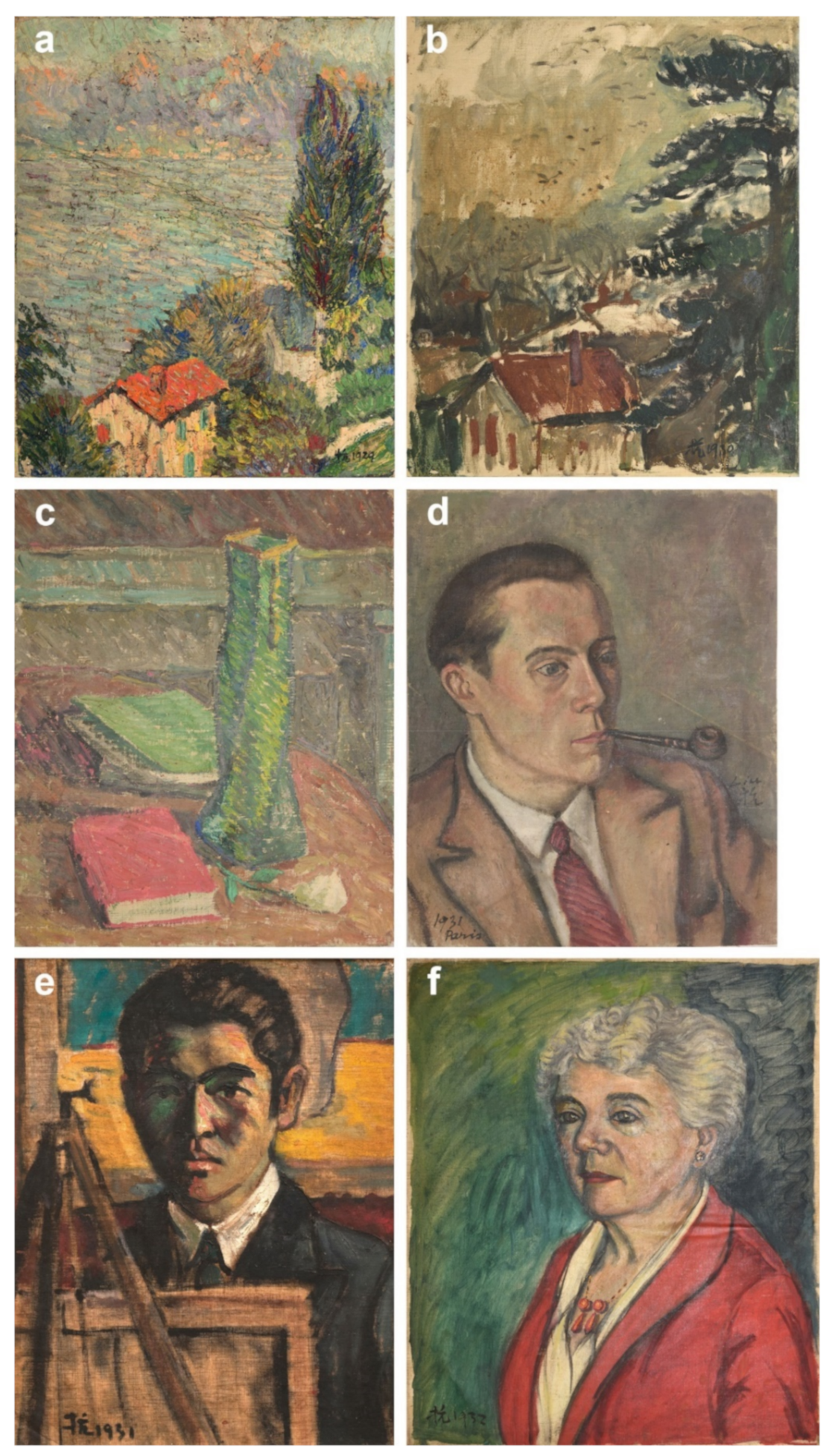


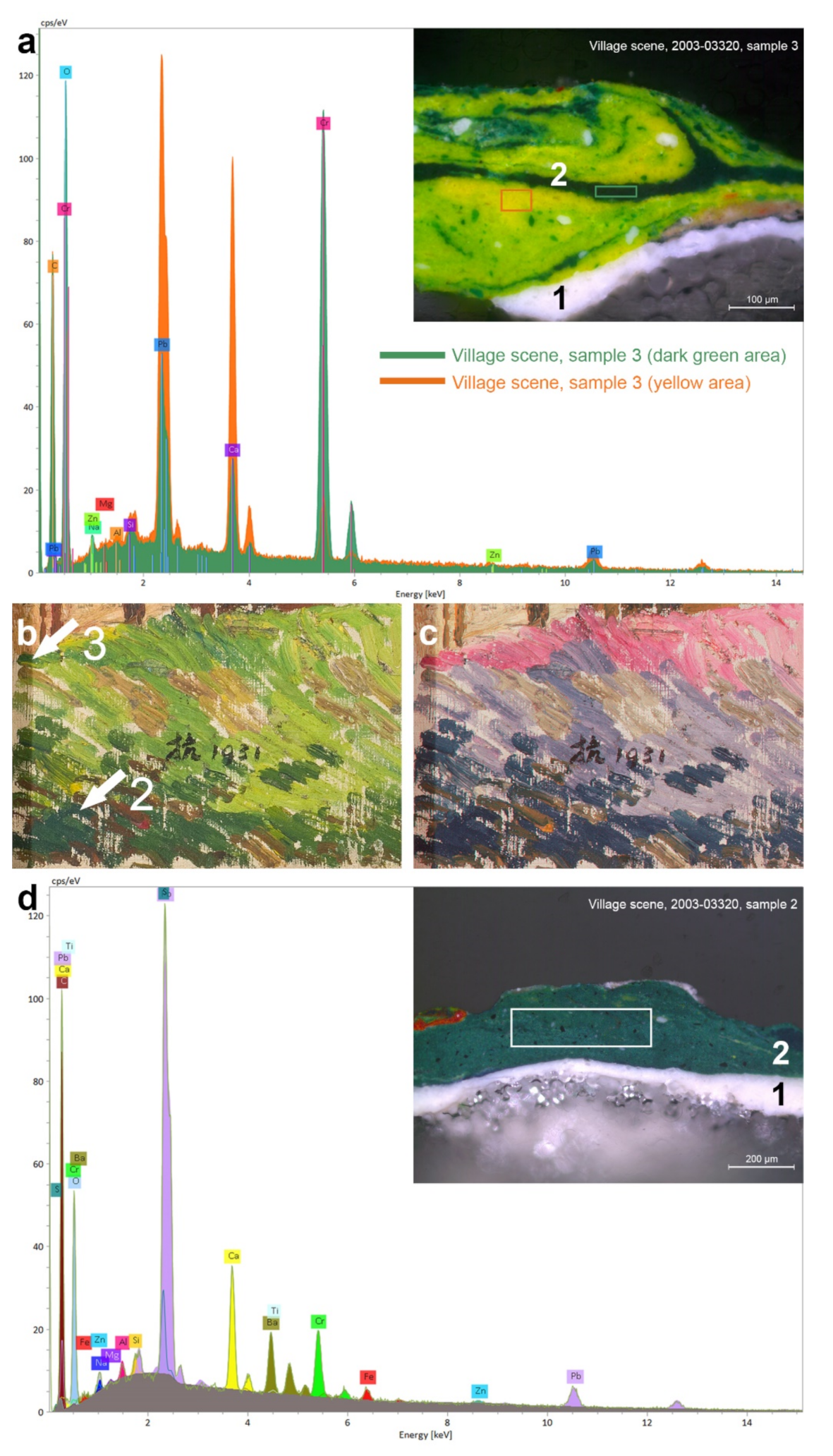
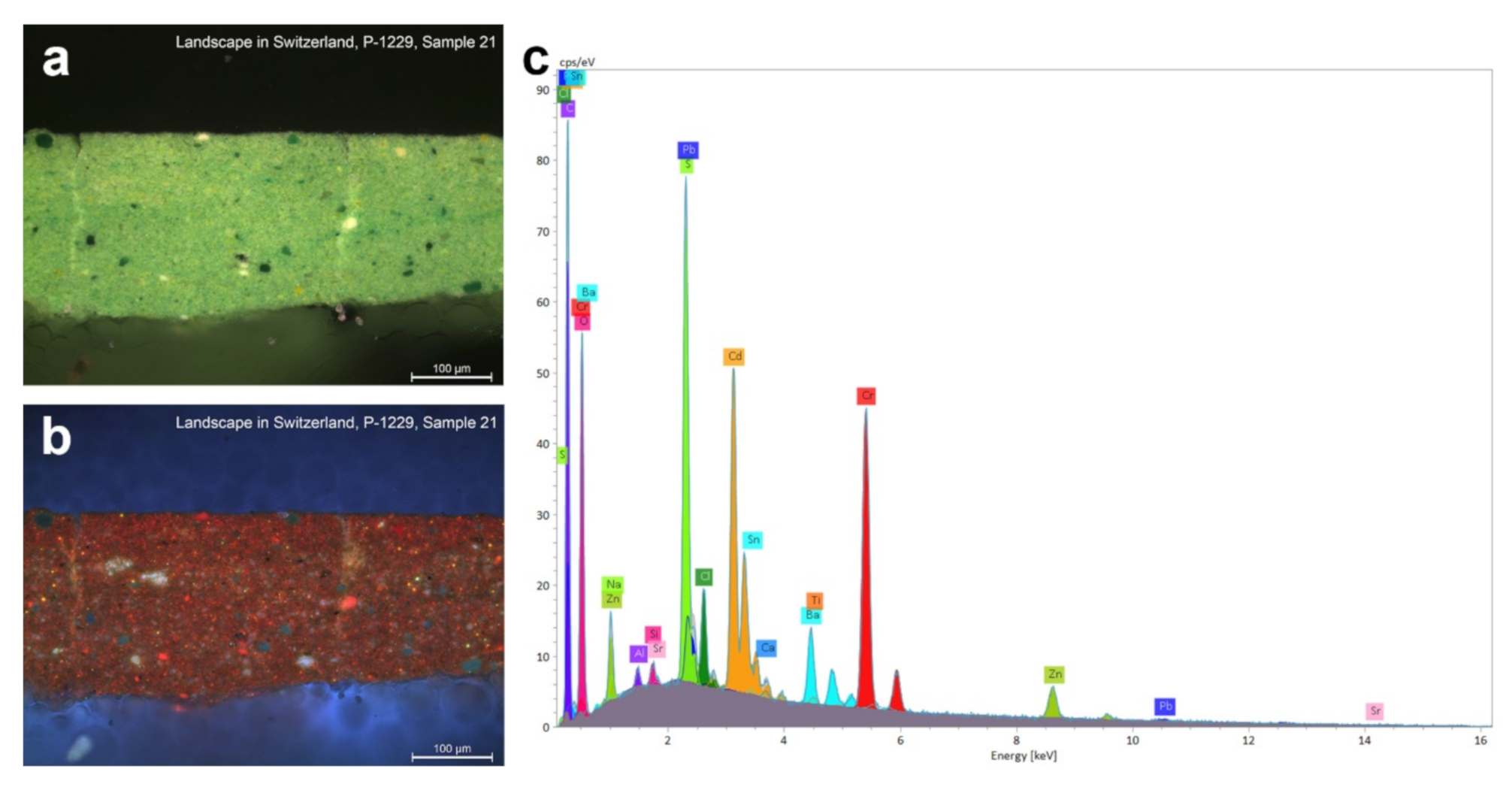
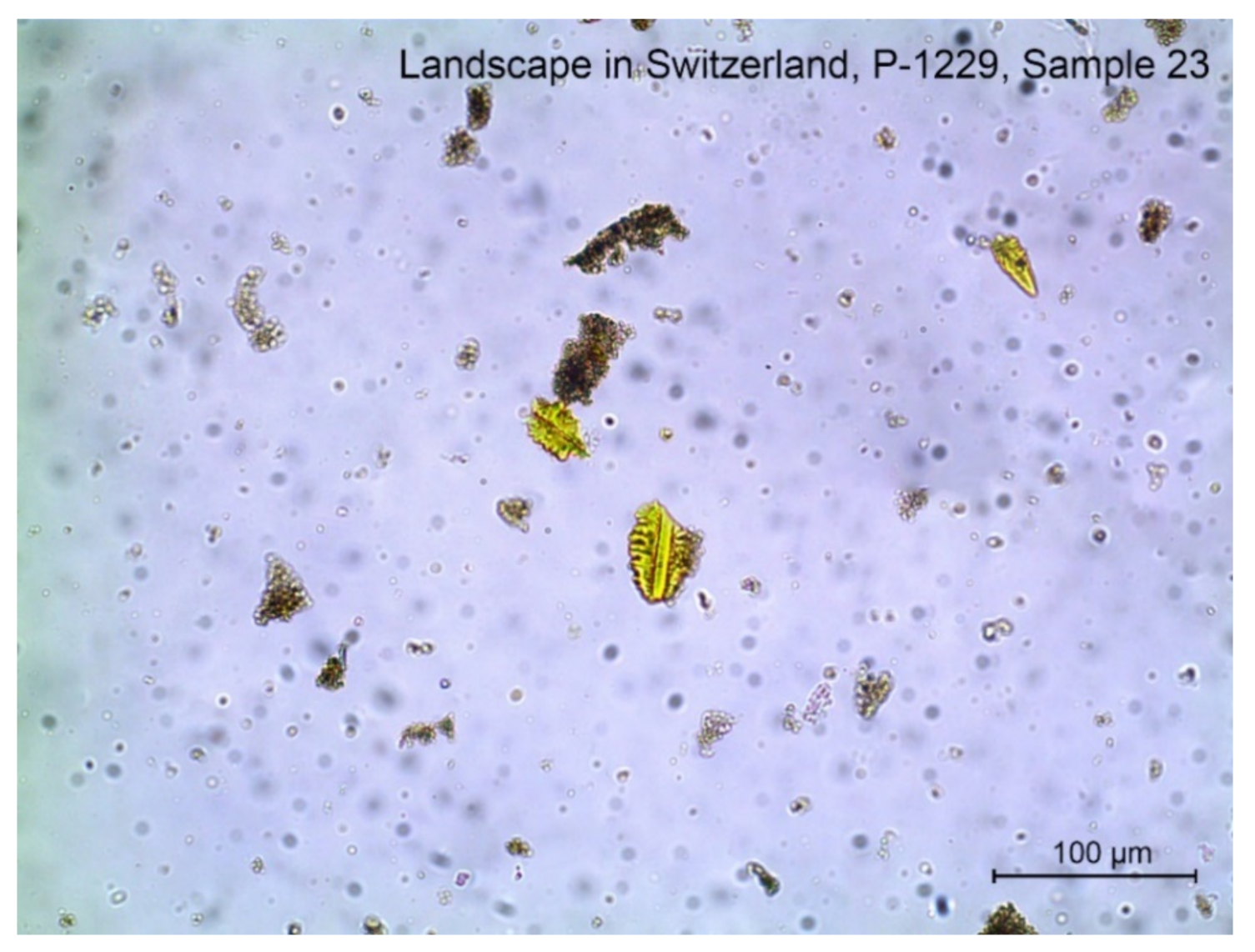

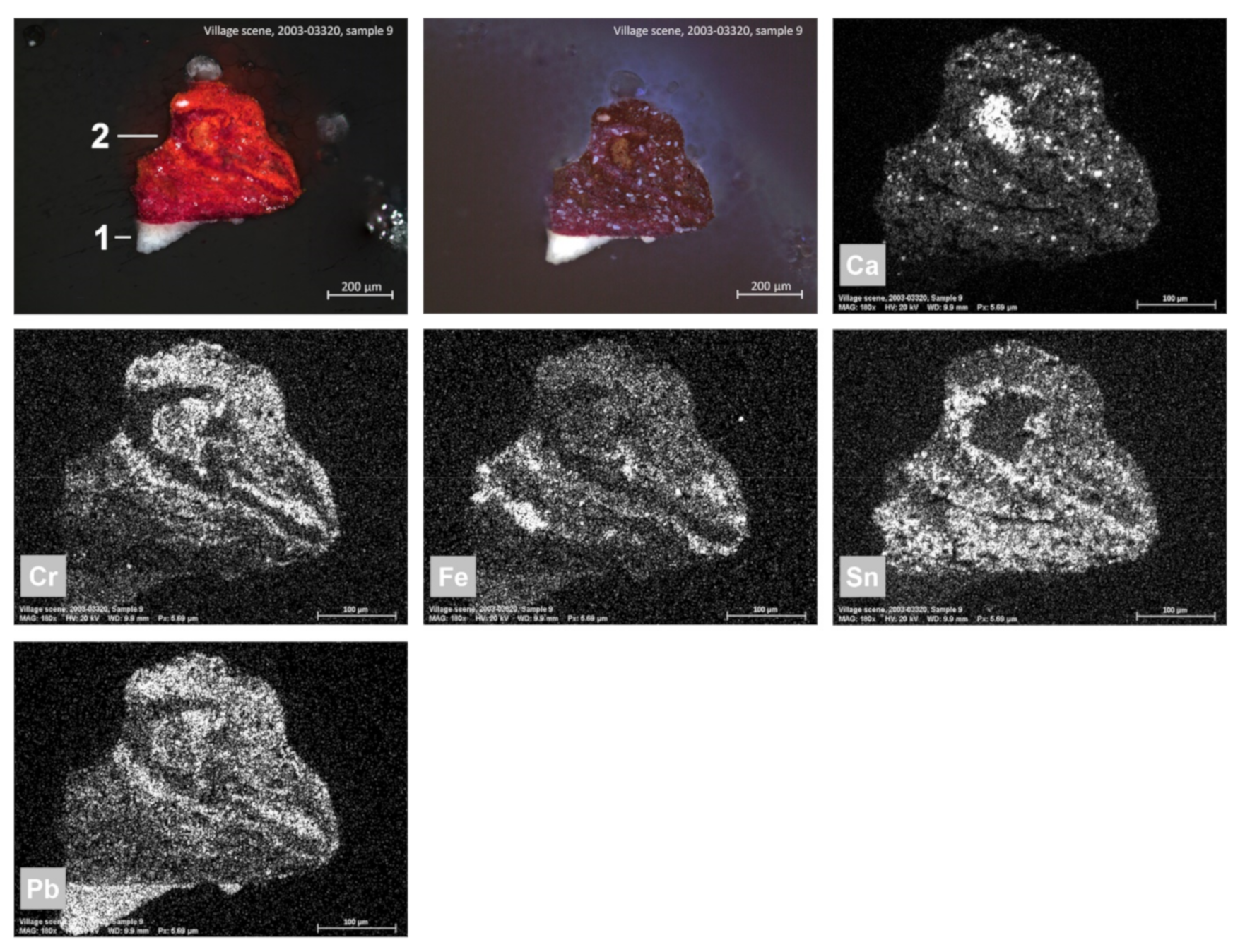
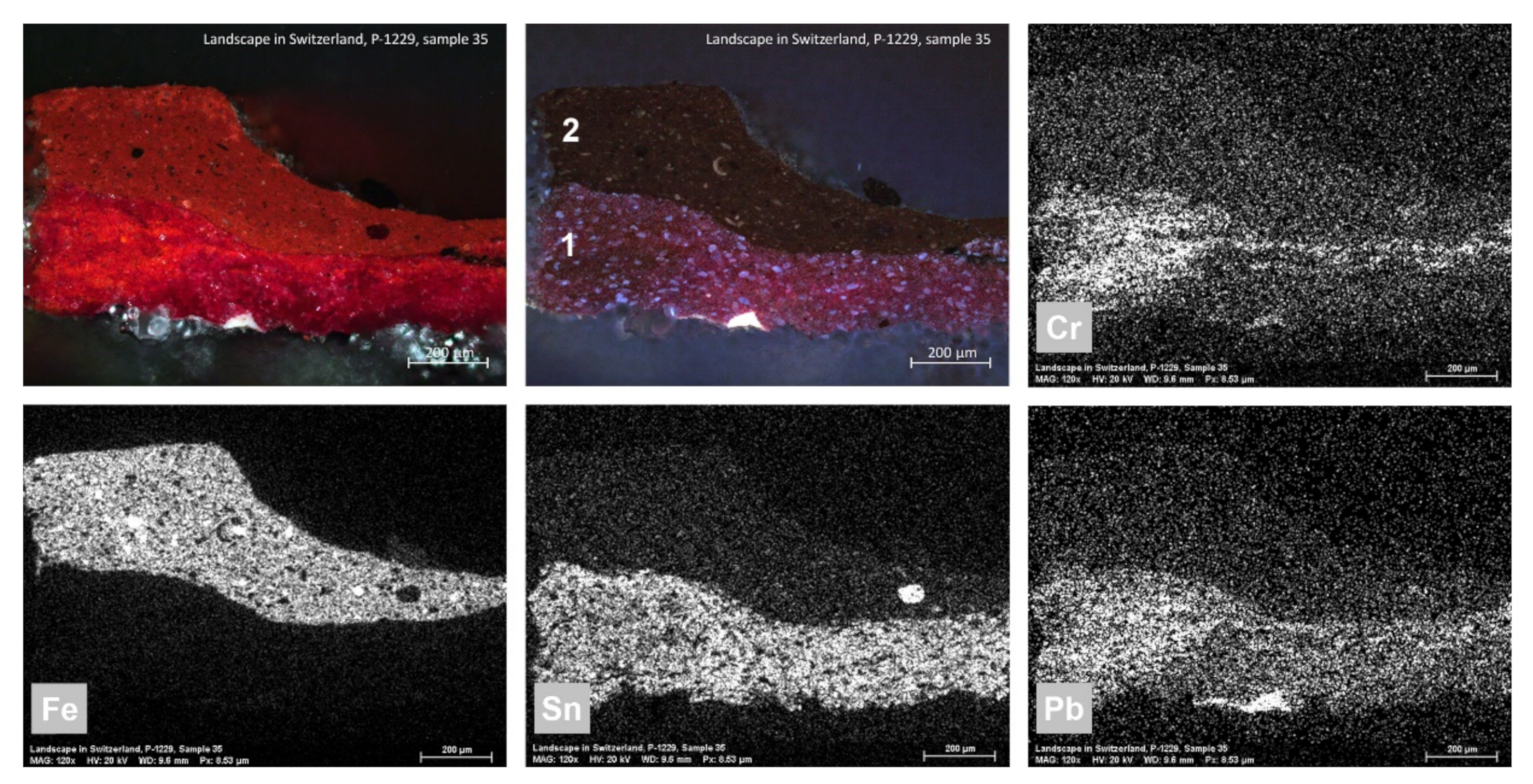
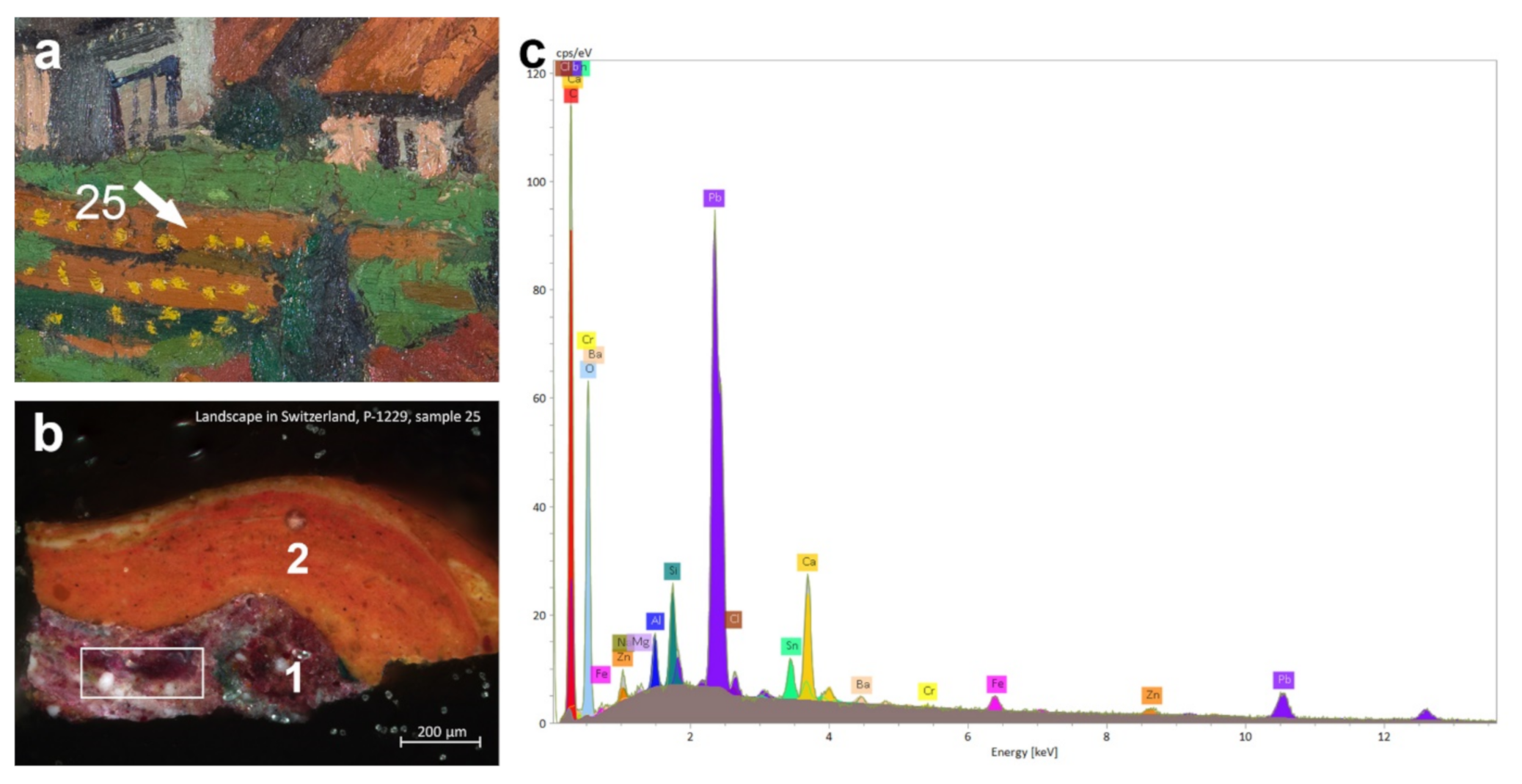


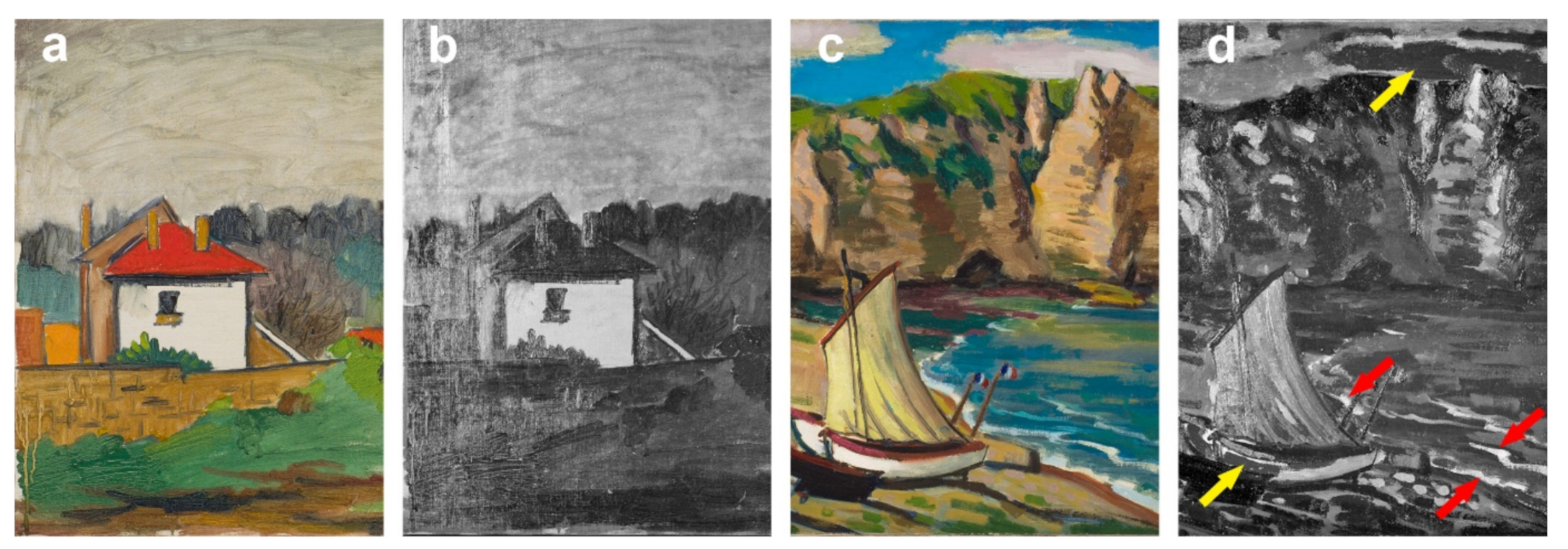

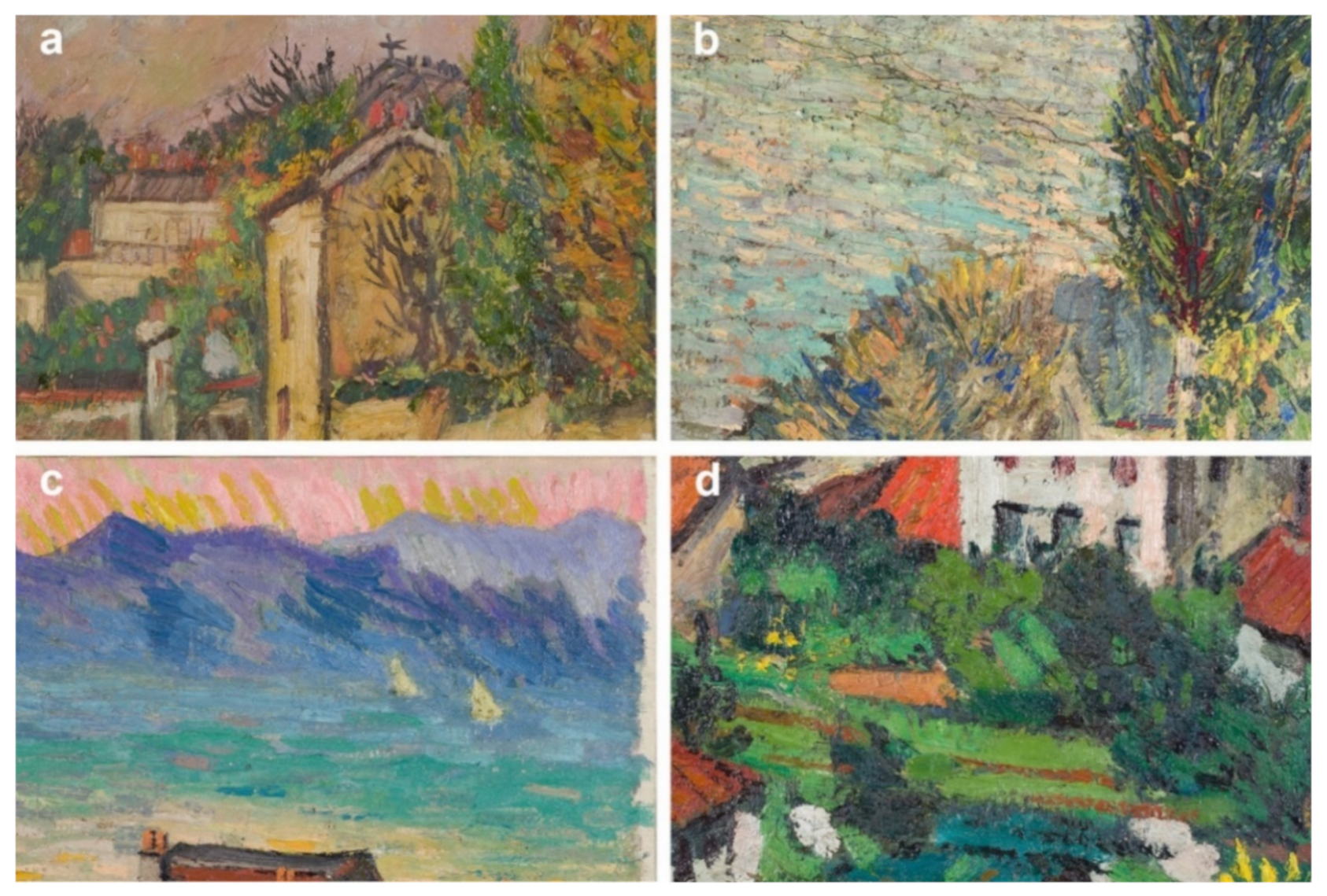

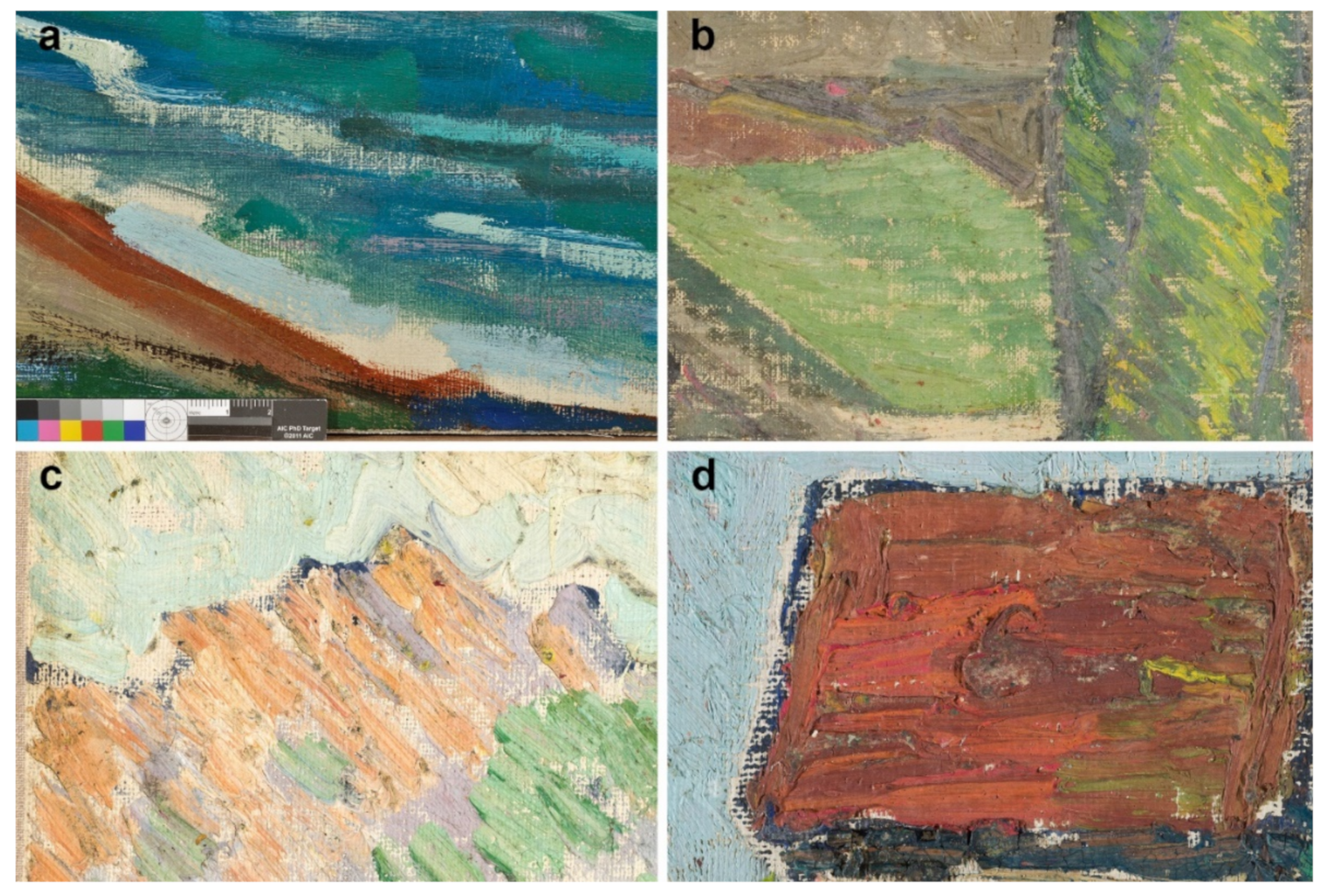
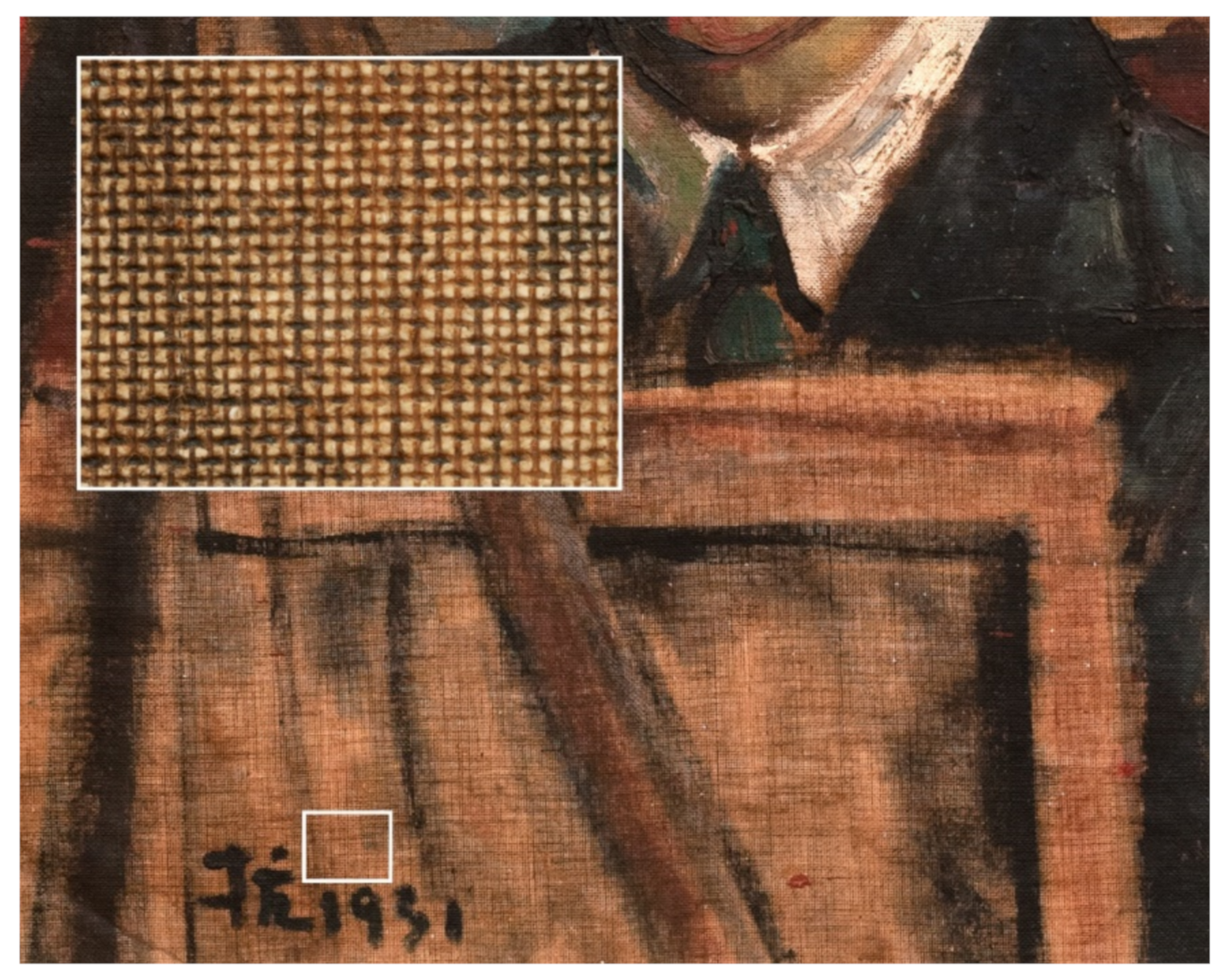


Publisher’s Note: MDPI stays neutral with regard to jurisdictional claims in published maps and institutional affiliations. |
© 2021 by the authors. Licensee MDPI, Basel, Switzerland. This article is an open access article distributed under the terms and conditions of the Creative Commons Attribution (CC BY) license (https://creativecommons.org/licenses/by/4.0/).
Share and Cite
Lizun, D.; Kurkiewicz, T.; Szczupak, B. Exploring Liu Kang’s Paris Practice (1929–1932): Insight into Painting Materials and Technique. Heritage 2021, 4, 828-863. https://0-doi-org.brum.beds.ac.uk/10.3390/heritage4020046
Lizun D, Kurkiewicz T, Szczupak B. Exploring Liu Kang’s Paris Practice (1929–1932): Insight into Painting Materials and Technique. Heritage. 2021; 4(2):828-863. https://0-doi-org.brum.beds.ac.uk/10.3390/heritage4020046
Chicago/Turabian StyleLizun, Damian, Teresa Kurkiewicz, and Bogusław Szczupak. 2021. "Exploring Liu Kang’s Paris Practice (1929–1932): Insight into Painting Materials and Technique" Heritage 4, no. 2: 828-863. https://0-doi-org.brum.beds.ac.uk/10.3390/heritage4020046







